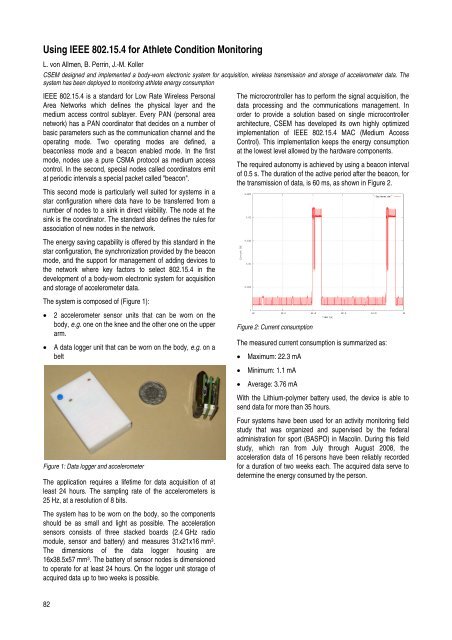CSEM Scientific and Technical Report 2008
CSEM Scientific and Technical Report 2008
CSEM Scientific and Technical Report 2008
Create successful ePaper yourself
Turn your PDF publications into a flip-book with our unique Google optimized e-Paper software.
Using IEEE 802.15.4 for Athlete Condition Monitoring<br />
L. von Allmen, B. Perrin, J.-M. Koller<br />
<strong>CSEM</strong> designed <strong>and</strong> implemented a body-worn electronic system for acquisition, wireless transmission <strong>and</strong> storage of accelerometer data. The<br />
system has been deployed to monitoring athlete energy consumption<br />
IEEE 802.15.4 is a st<strong>and</strong>ard for Low Rate Wireless Personal<br />
Area Networks which defines the physical layer <strong>and</strong> the<br />
medium access control sublayer. Every PAN (personal area<br />
network) has a PAN coordinator that decides on a number of<br />
basic parameters such as the communication channel <strong>and</strong> the<br />
operating mode. Two operating modes are defined, a<br />
beaconless mode <strong>and</strong> a beacon enabled mode. In the first<br />
mode, nodes use a pure CSMA protocol as medium access<br />
control. In the second, special nodes called coordinators emit<br />
at periodic intervals a special packet called "beacon".<br />
This second mode is particularly well suited for systems in a<br />
star configuration where data have to be transferred from a<br />
number of nodes to a sink in direct visibility. The node at the<br />
sink is the coordinator. The st<strong>and</strong>ard also defines the rules for<br />
association of new nodes in the network.<br />
The energy saving capability is offered by this st<strong>and</strong>ard in the<br />
star configuration, the synchronization provided by the beacon<br />
mode, <strong>and</strong> the support for management of adding devices to<br />
the network where key factors to select 802.15.4 in the<br />
development of a body-worn electronic system for acquisition<br />
<strong>and</strong> storage of accelerometer data.<br />
The system is composed of (Figure 1):<br />
• 2 accelerometer sensor units that can be worn on the<br />
body, e.g. one on the knee <strong>and</strong> the other one on the upper<br />
arm.<br />
• A data logger unit that can be worn on the body, e.g. on a<br />
belt<br />
Figure 1: Data logger <strong>and</strong> accelerometer<br />
The application requires a lifetime for data acquisition of at<br />
least 24 hours. The sampling rate of the accelerometers is<br />
25 Hz, at a resolution of 8 bits.<br />
The system has to be worn on the body, so the components<br />
should be as small <strong>and</strong> light as possible. The acceleration<br />
sensors consists of three stacked boards (2.4 GHz radio<br />
module, sensor <strong>and</strong> battery) <strong>and</strong> measures 31x21x16 mm3 .<br />
The dimensions of the data logger housing are<br />
16x38.5x57 mm3 . The battery of sensor nodes is dimensioned<br />
to operate for at least 24 hours. On the logger unit storage of<br />
acquired data up to two weeks is possible.<br />
82<br />
The microcrontroller has to perform the signal acquisition, the<br />
data processing <strong>and</strong> the communications management. In<br />
order to provide a solution based on single microcontroller<br />
architecture, <strong>CSEM</strong> has developed its own highly optimized<br />
implementation of IEEE 802.15.4 MAC (Medium Access<br />
Control). This implementation keeps the energy consumption<br />
at the lowest level allowed by the hardware components.<br />
The required autonomy is achieved by using a beacon interval<br />
of 0.5 s. The duration of the active period after the beacon, for<br />
the transmission of data, is 60 ms, as shown in Figure 2.<br />
Figure 2: Current consumption<br />
The measured current consumption is summarized as:<br />
• Maximum: 22.3 mA<br />
• Minimum: 1.1 mA<br />
• Average: 3.76 mA<br />
With the Lithium-polymer battery used, the device is able to<br />
send data for more than 35 hours.<br />
Four systems have been used for an activity monitoring field<br />
study that was organized <strong>and</strong> supervised by the federal<br />
administration for sport (BASPO) in Macolin. During this field<br />
study, which ran from July through August <strong>2008</strong>, the<br />
acceleration data of 16 persons have been reliably recorded<br />
for a duration of two weeks each. The acquired data serve to<br />
determine the energy consumed by the person.








